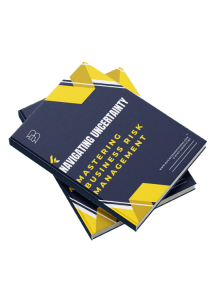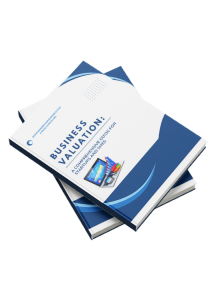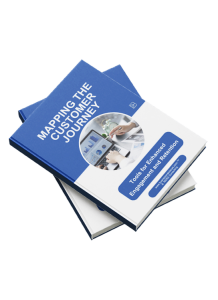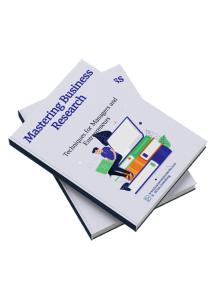Skip the textbook theory. Learn battle-tested business strategies from industry veterans who have walked the path before you.
Our program delivers practical, actionable knowledge across the fields of Strategic Management, Financial Management, Operations Management, Supply Chain Management, Investing, Marketing Management, Social Media Marketing, Sales Management, HR Management, IT, E-commerce, Machine Learning, Technology, and many other business areas, disciplines and functions.
In addition, the program provides you with the necessary Soft Skills and Motivational Content to add the necessary mental boost you need for your business success journey.
Because in business, experience outweighs theory every time. Transform your business acumen from classroom-smart to street-smart.
“At Business Mind Works, Real-World Success Meets Business Education”

This Video Explains Everything. Watch Now!
Transform Your Professional Journey
In today’s fast-paced business world, success isn’t just about working hard—it’s about working smart.
To build our program, we have distilled years of real-world business experience and financial expertise into comprehensive, action-oriented courses designed for ambitious professionals like you.
Why do 90% of businesses fail within their first five years? Often, it’s not due to lack of effort, but rather a gap in crucial business knowledge and strategic insight.
Our carefully curated program bridges this gap, offering you the exact tools, frameworks, and strategies that successful entrepreneurs and business leaders use to thrive in today’s competitive landscape.
“The Street Smart Business Program: Your Complete Business Arsenal”

Whether you are dreaming of launching your own venture, climbing the corporate ladder, or maximizing your investment potential, our expert-led courses provide more than just theory—they deliver practical, implementable knowledge that transforms aspirations into achievements. Each course is designed to give you an edge in critical business areas.
“Do not just chase success—Architect it.”
Join the large number of professionals who have already leveraged our program to accelerate their career growth and business success. Your journey toward financial independence and professional mastery starts here.

Step into a world of comprehensive business education with our flagship offering—a powerhouse collection of over 85 detailed e-books and 200 professional video courses, thoughtfully designed to transform you into a business virtuoso.

As an added value to our already successful program, we provide an extensive library of over 800 business and finance Excel templates—real-world tools that you can implement immediately to streamline your operations, enhance your decision-making, and drive results.
Understanding that technical skills alone don’t guarantee success, we have integrated an extensive collection of soft skills development resources and motivational content.
These carefully selected e-books and videos tutorials will help you develop the leadership presence, communication expertise, and mental resilience needed to excel in today’s business environment.

The Value Proposition That Sets Us Apart
Whether you’re dreaming of launching your own venture, climbing the corporate ladder, or maximizing your investment potential, our expert-led program provides more than just theory—it delivers practical, implementable knowledge that transforms aspirations into achievements.
Each component is designed to give you an edge in critical areas like financial management, strategic planning, market analysis, and business development.
Imagine transforming your aspirations into reality
Our expert-led courses cover a wide array of topics, from strategic management and entrepreneurship to investment strategies and personal finance.
Each module is crafted to equip you with practical skills and insights that you can immediately apply in your professional life.
Ready to invest in your future?
Explore The Street Smart Business Program and take the first step toward turning your ambitions into reality.
With an investment that equals much less than the cost of a single university course, you will gain access to a complete business education that delivers lasting value for years to come.
Testimonials
Click here to invest/ purchase the program
Note that this is a one time payment of 195 USD only!

The Street Smart Business Program Membership
We would like to inform you about an important additional benefit you will be eligible to receive, once you invest in the Street Smart Business Program, and which is your exclusive membership with Business Mind Works club.
This enhanced membership delivers ongoing value to support your entrepreneurial journey.
As a member, you will receive:
– Monthly Business Educational Products: Each month, we will deliver fresh, actionable content directly to you, ensuring you stay ahead of the curve in today’s dynamic business environment.
– Continuous Learning Resources: Access our growing library of business education materials, tools, and resources designed to help you scale your success.
– Continuous Access: Your benefits continue – no renewals needed no additional fees.
Your continuous monthly educational package will include valuable content like:
– Strategic business guides
– Market analysis tools
– Leadership development resources
– Practical implementation frameworks
– Other valuable resources
In addition to the mentioned, we will be conducting on a regular basis, business contests with valuable prizes offered to the winners, like limited edition business courses and tools, as well as business coaching sessions with our CEO.
“We are committed to your long-term success and look forward to being part of your business growth journey”
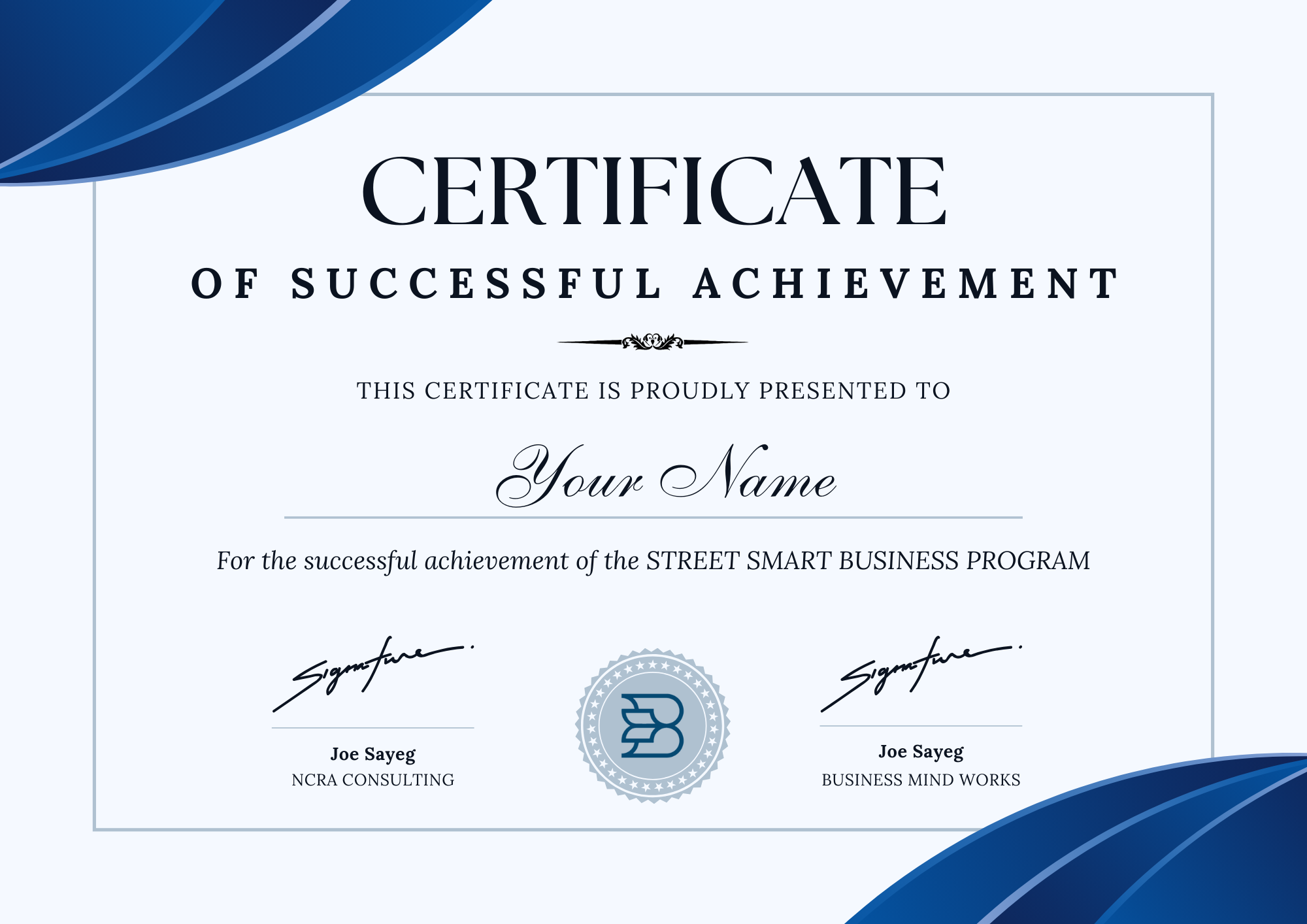
Certificate of Program Successful Completion by Business Mind Works
Our clients/associates who have invested in the Street-Smart Business Program by Business Mind Works, are eligible to receive a Certificate of Successful Completion.
To qualify for the certificate:
- Participants must complete the program curriculum
- Successfully pass an examination covering 10 key topics from the program
- Achieve a passing score of 80/100 in the assessment
Upon meeting these requirements, Business Mind Works will provide a signed and stamped Certificate of Successful Completion recognizing your achievement in the program.
The examination will test your knowledge of essential concepts covered throughout the program’s courses.
Successful completion demonstrates your mastery of the program material and commitment to professional development.
For more information about the certification process or to schedule your examination, please contact Business Mind Works directly.
A Wealth of knowledge: Review some of our courses collection!
Ebooks - Management
Business Law
Table of Contents
Chapter 1: Introduction to Business Law
Understanding Business Law
Importance of Business Law for Managers and Entrepreneurs Overview of Legal Frameworks
Chapter 2: Corporate Governance Law
Principles of Corporate Governance
Roles and Responsibilities of Directors
Compliance and Regulatory Frameworks
Chapter 3: Intellectual Property Law
Types of Intellectual Property
Protecting Intellectual Property Rights
Enforcement and Litigation
Chapter 4: Employment and Labor Law
Employment Contracts
Employee Rights and Employer Obligations
Workplace Policies and Compliance
Chapter 5: Contract Law
Elements of a Valid Contract
Types of Contracts in Business
Breach of Contract and Remedies
Chapter 6: Mergers and Acquisitions Law
Overview of Mergers and Acquisitions
Due Diligence Process
Regulatory Considerations
Chapter 7: International Business Law
Cross‐Border Transactions
International Trade Regulations
Dispute Resolution in International Business
Chapter 8: Bankruptcy and Insolvency Law
Understanding Bankruptcy
Types of Bankruptcy Proceedings
Rights of Creditors and Debtors
Chapter 9: Taxation Law
Business Tax Obligations
Tax Planning Strategies
Compliance and Reporting
Chapter 10: Commercial Real Estate Law
Real Estate Transactions
Leasing and Property Management
Zoning and Land Use Regulations
Chapter 11: E‐commerce and Cybersecurity Law
Legal Issues in E‐commerce
Data Protection and Privacy Laws
Cybersecurity Compliance
Chapter 12: Conclusion
The Evolving Landscape of Business Law
Future Trends for Managers and Entrepreneurs
Resources for Further Learning
Navigating Business Success
Table of Contents
Chapter 1: Introduction to Business Success
Defining Success in Business
The Role of Entrepreneurs and Managers
Overview of Key Strategies
Chapter 2: Strategic Planning
Importance of a Business Plan
Setting Clear Goals and Objectives
Analyzing the Market Environment
Chapter 3: Financial Management
Understanding Financial Statements
Budgeting and Forecasting
Managing Cash Flow
Chapter 4: Marketing Strategies
Identifying Target Markets
Developing a Unique Value Proposition
Utilizing Digital Marketing
Chapter 5: Leadership and Team Building
Characteristics of Effective Leaders
Building a High-Performing Team
Conflict Resolution and Communication
Chapter 6: Operational Efficiency
Streamlining Business Processes
Implementing Technology Solutions
Measuring Performance and Productivity
Chapter 7: Customer Relationship Management
Importance of Customer Satisfaction
Strategies for Building Customer Loyalty
Utilizing Feedback for Improvement
Chapter 8: Innovation and Adaptability
Fostering a Culture of Innovation
Adapting to Market Changes
Case Studies of Successful Innovation
Chapter 9: Risk Management
Identifying Business Risks
Developing a Risk Mitigation Plan
Crisis Management Strategies
Chapter 10: Networking and Partnerships
Building Professional Relationships
Leveraging Strategic Alliances
The Role of Mentorship
Chapter 11: Measuring Success
Key Performance Indicators (KPIs)
Evaluating Business Performance
Continuous Improvement Practices
Chapter 12: Conclusion and Future Trends
Recap of Key Strategies
Preparing for Future Challenges
Final Thoughts on Business Success
Competitive Edge
Table of Contents
Chapter 1: Introduction to Competitive Edge
Understanding Market Forces
Importance of Strategic Positioning
Overview of Key Concepts
Chapter 2: Business Strategy Fundamentals
Defining Business Strategy
Core Elements of Effective Strategies
Aligning Vision and Strategy
Chapter 3: Digital Transformation Strategy
The Role of Digital in Business
Frameworks for Digital Transformation
Case Studies of Successful Transformation
Chapter 4: Sustainable Business Practices
Importance of Sustainability in Business
Strategies for Sustainable Practices
Measuring Sustainability Impact
Chapter 5: Market Entry Strategies
Analyzing Market Opportunities
Entry Modes and Their Implications
Developing a Market Entry Plan
Chapter 6: Competitive Analysis and Positioning
Understanding Competitive Landscape
Tools for Competitive Analysis
Positioning Strategies for Success
Chapter 7: Innovation and Product Development Strategies
Importance of Innovation in Business
Stages of Product Development
Fostering a Culture of Innovation
Chapter 8: Organizational Change Management
Principles of Change Management
Strategies for Effective Change Implementation
Overcoming Resistance to Change
Chapter 9: Strategic Partnerships and Alliances
Identifying Potential Partners
Building and Managing Alliances
Evaluating Partnership Success
Chapter 10: Global Expansion Strategies
Assessing Global Market Potential
Strategies for International Growth
Navigating Cultural Differences
Chapter 11: Customer-Centric Business Strategies
Understanding Customer Needs
Developing Customer Engagement Strategies
Measuring Customer Satisfaction
Chapter 12: Data-Driven Decision Making in Business Strategy
Importance of Data in Strategy Development
Tools and Techniques for Data Analysis
Case Studies of Data-Driven Success
Chapter 13: Conclusion and Future Trends
Recap of Key Insights
Emerging Trends in Business Strategy
Preparing for Future Challenges
Business Automation
Table of Contents
Chapter 1: Introduction to Business Automation
The Importance of Automation in Today’s Business Landscape
Identifying Opportunities for Automation
Overview of Automation Tools
Chapter 2: Workflow Automation for Small Businesses
Defining Workflow Automation
Benefits of Streamlining Workflows
Tools and Technologies for Workflow Automation
Chapter 3: Marketing Automation Tools for E-Commerce
Understanding Marketing Automation
Key Tools for E-Commerce Marketing
Best Practices for Implementing Marketing Automation
Chapter 4: Customer Relationship Management (CRM) Automation
The Role of CRM in Business Success
Features of Effective CRM Automation
Choosing the Right CRM System
Chapter 5: Human Resources Automation Solutions
Automating HR Processes
Benefits of HR Automation
Tools for HR Automation
Chapter 6: Financial and Accounting Process Automation
The Need for Financial Automation
Common Financial Processes to Automate
Software Solutions for Accounting Automation
Chapter 7: Project Management Automation Software
Automating Project Management Tasks
Key Features of Project Management Tools
Implementing Automation in Project Management
Chapter 8: Inventory Management Automation for Retailers
Importance of Inventory Management
Automation Solutions for Inventory Control
Integrating Inventory Automation with Other Systems
Chapter 9: Automated Reporting and Analytics
The Value of Automated Reporting
Tools for Data Analytics Automation
Best Practices for Reporting Automation
Chapter 10: Email Marketing Automation Strategies
The Benefits of Email Marketing Automation
Key Components of an Effective Strategy
Tools for Email Marketing Automation
Chapter 11: Chatbot Automation for Customer Service
Understanding Chatbots and Their Role
Benefits of Using Chatbots in Customer Service
Implementing Chatbot Solutions
Chapter 12: Future Trends in Business Automation
Emerging Technologies in Automation
Preparing for the Future of Work
Final Thoughts on Automation and Efficiency
Continous Improvement Kaizen
Table of Contents
Chapter 1: Introduction to Kaizen
The Philosophy of Continuous Improvement
History and Evolution of Kaizen
Importance of Kaizen in Modern Manufacturing
Chapter 2: Implementing Kaizen in Manufacturing
Assessing Current Processes
Identifying Areas for Improvement
Developing a Kaizen Implementation Plan
Training and Engaging Employees
Chapter 3: Kaizen for Personal Development
Setting Personal Improvement Goals
Daily Practices for Continuous Growth
Measuring Progress and Making Adjustments
Chapter 4: Kaizen in Healthcare
Enhancing Patient Care Through Continuous Improvement
Streamlining Operations in Healthcare Facilities
Case Studies of Successful Kaizen Implementation
Chapter 5: Kaizen in Education
Improving Teaching Methods
Enhancing Student Engagement and Outcomes
Building a Kaizen Culture in Educational Institutions
Chapter 6: Kaizen for Small Businesses
Tailoring Kaizen Principles for Small Enterprises
Cost-Effective Implementation Strategies
Success Stories from Small Business Owners
Chapter 7: Kaizen in Project Management
Integrating Kaizen into Project Planning
Continuous Improvement Throughout the Project Lifecycle
Tools and Techniques for Project Managers
Chapter 8: Kaizen for Remote Teams
Adapting Kaizen Principles to Remote Work
Fostering Collaboration and Communication
Measuring Remote Team Efficiency
Chapter 9: Kaizen in Software Development
Agile Methodologies and Continuous Improvement
Enhancing Code Quality and Team Productivity
Real-World Examples of Kaizen in Software Projects
Chapter 10: Kaizen Principles for Home Organization
Applying Kaizen to Personal Spaces
Techniques for Sustaining an Organized Home
Benefits of Home Organization through Kaizen
Chapter 11: Kaizen for Lean Supply Chain Management
Understanding Lean Principles
Streamlining Supply Chain Operations
Measuring Success in Lean Supply Chains
Chapter 12: Conclusion and Future of Kaizen
The Future of Continuous Improvement
Expanding Kaizen Beyond Manufacturing
Final Thoughts on Kaizen as a Cultural Shift
Mastering Employees Engagement
Table of Contents
Chapter 1: Understanding Employee Engagement
Defining Employee Engagement
The Importance of Engagement in Organizations
The Impact of Engagement on Performance
Effective Recruitment Techniques
The Role of Employer Branding
Chapter 3: Building Effective Employee Engagement Programs
Key Components of Engagement Programs
Designing Tailored Engagement Initiatives
Measuring Engagement Success
Chapter 4: Retention Strategies for Thriving Organizations
Understanding Employee Turnover
Implementing Retention Programs
Creating a Positive Work Environment
Chapter 5: Performance Management Systems
Objectives of Performance Management
Best Practices for Performance Reviews
Linking Performance to Employee Engagement
Chapter 6: Diversity and Inclusion Initiatives
The Business Case for Diversity
Creating an Inclusive Workplace Culture
Measuring Diversity and Inclusion Success
Chapter 7: Leveraging HR Technology and Automation
The Role of Technology in HR
Tools for Enhancing Employee Engagement
Future Trends in HR Technology
Chapter 8: Compensation and Benefits Analysis
Aligning Compensation with Engagement
Innovative Benefits Strategies
Assessing Compensation Competitiveness
Chapter 9: Training and Development Solutions
Importance of Continuous Learning
Developing Effective Training Programs
Linking Development to Engagement
Chapter 10: Conflict Resolution and Mediation
Understanding Workplace Conflict
Strategies for Conflict Resolution
Role of Mediation in Employee Engagement
Chapter 11: Labor Law Compliance and Regulations
Navigating Employment Laws
Best Practices for Legal Adherence
Chapter 12: Organizational Development and Change Management
The Need for Organizational Development
Managing Change Effectively
Ensuring Engagement During Transitions
Chapter 13: Creating a Culture of Engagement
Leadership's Role in Engagement
Communicating for Engagement
Sustaining Engagement Over Time
Business Risk Management
Table of Contents
Chapter 1: Understanding Business Risk Management
Definition and Importance
Types of Business Risks
The Risk Management Process
Chapter 2: Cybersecurity Risk Management
Identifying Cyber Risks
Developing a Cybersecurity Strategy
Incident Response Planning
Chapter 3: Financial Risk Assessment
Types of Financial Risks
Risk Assessment Techniques
Mitigation Strategies
Chapter 4: Operational Risk Mitigation
Understanding Operational Risks
Risk Control Measures
Performance Monitoring
Chapter 5: Supply Chain Risk Management
Identifying Supply Chain Risks
Strategies for Risk Reduction
Resilience in Supply Chains
Chapter 6: Regulatory Compliance Risk
Overview of Regulatory Risks
Compliance Frameworks
Monitoring and Reporting
Chapter 7: Reputation Risk Management
Understanding Reputation Risks
Building a Strong Brand Image
Crisis Communication Strategies
Chapter 8: Environmental Risk Assessment
Identifying Environmental Risks
Compliance with Environmental Regulations
Sustainable Business Practices
Chapter 9: Strategic Risk Management
Aligning Risk with Business Strategy
Tools for Strategic Risk Assessment
Long-term Planning
Chapter 10: Crisis Management and Business Continuity
Developing a Crisis Management Plan
Business Continuity Planning
Recovery Strategies
Chapter 11: Insurance and Risk Transfer Strategies
Understanding Insurance Fundamentals
Risk Transfer Mechanisms
Evaluating Insurance Options
Chapter 12: Future Trends in Risk Management
Emerging Risks
Technology and Risk Management
Preparing for the Unknown
Navigating Corporate Change
Table of Contents
Chapter 1: Understanding Business Restructuring
The Necessity of Restructuring
Types of Business Restructuring
Common Challenges in Restructuring
Chapter 2: Business Process Restructuring
Identifying Inefficiencies
Process Mapping Techniques
Best Practices for Process Redesign
Chapter 3: Lean Six Sigma Implementation
Principles of Lean Six Sigma
Tools and Techniques
Case Studies of Successful Implementation
Chapter 4: Digital Transformation Strategies
Defining Digital Transformation
Key Technologies Driving Change
Building a Digital Transformation Roadmap
Chapter 5: Change Management in Business Restructuring
The Role of Change Management
Strategies for Effective Change Management
Communicating Change
Chapter 6: Agile Methodologies for Process Improvement
Introduction to Agile Methodologies
Implementing Agile in Restructuring
Measuring Agile Success
Chapter 7: Cost Reduction through Process Optimization
Identifying Cost Drivers
Techniques for Cost Reduction
Tracking Cost Savings
Chapter 8: Supply Chain Restructuring Techniques
Analyzing Supply Chain Inefficiencies
Strategies for Supply Chain Optimization
Leveraging Technology in Supply Chain Restructuring
Chapter 9: Employee Engagement in Process Changes
Importance of Employee Buy-In
Techniques to Enhance Engagement
Measuring Employee Engagement
Chapter 10: Technology Integration for Process Automation
Evaluating Automation Opportunities
Selecting the Right Technologies
Challenges in Technology Integration
Chapter 11: Risk Management in Business Restructuring
Identifying Risks in Restructuring
Risk Assessment Frameworks
Mitigating Risks
Chapter 12: Performance Metrics and KPIs for Process Evaluation
Establishing Key Performance Indicators
Evaluating Process Performance
Continuous Improvement through Metrics
Project Management
Table of Contents
Chapter 1: Introduction to Project Management
Definition and Importance of Project Management
The Role of a Project Manager
Key Skills Required for Effective Project Management
Chapter 2: Agile Project Management
Principles of Agile Methodology
Implementing Agile in Projects
Benefits and Challenges of Agile Project Management
Chapter 3: Construction Project Management
Overview of Construction Projects
Planning and Scheduling Techniques
Safety and Compliance in Construction Projects
Chapter 4: IT Project Management
Unique Challenges in IT Projects
Software Development Life Cycle (SDLC)
Tools and Techniques for IT Project Management
Chapter 5: Remote Project Management
Managing Teams in a Remote Environment
Communication Strategies for Remote Teams
Tools for Effective Remote Project Management
Chapter 6: Risk Management in Projects
Identifying Project Risks
Risk Assessment and Prioritization
Mitigation Strategies and Contingency Planning
Chapter 7: Project Management Software Solutions
Overview of Project Management Tools
Comparing Popular Project Management Software
Selecting the Right Tool for Your Project
Chapter 8: Project Portfolio Management
Definition and Importance of Portfolio Management
Aligning Projects with Business Strategy
Evaluating and Prioritizing Projects
Chapter 9: Sustainable Project Management
Principles of Sustainable Project Management
Integrating Sustainability into Project Planning
Measuring the Impact of Sustainable Practices
Chapter 10: Conclusion and Future Trends in Project Management
Evolution of Project Management Practices
Emerging Trends and Technologies
Preparing for the Future of Project Management
Management Quality Revolution
Table of Contents
Chapter 1: Introduction to Quality Management
Understanding Total Quality Management
The Evolution of Lean Six Sigma
The Importance of Quality in Business
Chapter 2: Principles of Total Quality Management
Customer Focus
Leadership Commitment
Employee Involvement
Chapter 3: Lean Six Sigma Fundamentals
Defining Lean and Six Sigma
The DMAIC Process
Tools and Techniques
Chapter 4: Integrating TQM and Lean Six Sigma
Synergies Between TQM and Lean Six Sigma
Developing a United Quality Strategy
Case Studies of Successful Integration
Chapter 5: Implementing Total Quality Management
Creating a Quality Culture
Training and Development
Measuring Performance
Chapter 6: Lean Six Sigma Implementation
Identifying Improvement Opportunities
Project Selection and Prioritization
Managing Change
Chapter 7: Tools for Quality Improvement
Statistical Process Control
Root Cause Analysis
Process Mapping
Chapter 8: Leadership in Quality Management
The Role of Leadership in Quality Initiatives
Building a Quality-Oriented Team
Communicating Quality Goals
Chapter 9: Overcoming Challenges in Quality Management
Common Obstacles to Implementation
Strategies for Sustaining Quality Improvements
Engaging Stakeholders
Chapter 10: Measuring Success and Continuous Improvement
Key Performance Indicators
Feedback Mechanisms
The Cycle of Continuous Improvement
Chapter 11: Future Trends in Quality Management
The Role of Technology in Quality
Emerging Practices in TQM and Lean Six Sigma
Preparing for the Future of Quality Management
Chapter 12: Conclusion and Next Steps
Recap of Key Concepts
Developing an Action Plan
Resources for Further Learning
Appendix: TQM inforgraphic
Restructuring For Success
Table of Contents
Chapter 1: Introduction to Restructuring for Success
The Need for Business Process Restructuring
Overview of Lean Strategies
The Importance of Digital Transformation
Chapter 2: Lean Process Improvement
Principles of Lean Thinking
Identifying Waste in Business Processes
Tools and Techniques for Lean Improvement
Chapter 3: Digital Transformation Strategies
Understanding Digital Transformation
Key Technologies Driving Change
Integrating Digital Initiatives with Lean Processes
Chapter 4: Change Management Frameworks
The Role of Change Management in Restructuring
Popular Change Management Models
Strategies for Effective Change Communication
Chapter 5: Workflow Optimization Tools
Defining Workflow Optimization
Key Tools for Workflow Management
Best Practices for Implementing Optimization Tools
Chapter 6: Employee Engagement in Restructuring
The Importance of Employee Buy-In
Strategies for Enhancing Engagement
Measuring Employee Engagement During Change
Chapter 7: Cost Reduction Techniques
Identifying Cost Reduction Opportunities
Lean Techniques for Cost Efficiency
Balancing Cost Reduction and Quality
Chapter 8: Cross-Functional Collaboration Models
The Importance of Collaboration in Restructuring
Models for Effective Cross-Functional Teams
Fostering a Collaborative Culture
Chapter 9: Performance Metrics and KPIs
Defining Key Performance Indicators
Aligning KPIs with Business Goals
Techniques for Monitoring and Reporting Performance
Chapter 10: Agile Methodologies in Business Processes
Understanding Agile Principles
Implementing Agile in Non-Traditional Environments
Benefits of Agile for Restructuring Efforts
Chapter 11: Risk Management in Restructuring Efforts
Identifying Risks in Restructuring
Frameworks for Effective Risk Management
Mitigating Risks During Transformation
Chapter 12: Case Studies in Successful Restructuring
Analyzing Successful Lean Transformations
Lessons Learned from Digital Transformation Efforts
Key Takeaways for Managers and Entrepreneurs
Chapter 13: Conclusion and Future Trends
The Future of Business Process Restructuring
Emerging Trends in Lean and Digital Strategies
Final Thoughts on Achieving Success Through Restructuring
Ebooks - Finance & Financial Management
The Entrepreneur's Accounting Handbook
Table of Contents
Chapter 1: Introduction to Accounting for Entrepreneurs
Importance of Accounting in Business
Overview of Accounting Types
Key Accounting Principles
Chapter 2: Basic Accounting Concepts
The Accounting Equation
Double-Entry Bookkeeping
Financial Statements Overview
Chapter 3: Financial Accounting Fundamentals
The Balance Sheet
Income Statement
Cash Flow Statement
Chapter 4: Tax Accounting Essentials
Understanding Tax Obligations
Tax Deductions and Credits
Filing Taxes for Small Businesses
Chapter 5: Management Accounting Techniques
Budgeting and Forecasting
Performance Measurement
Decision-Making Tools
Chapter 6: Cost Accounting Practices
Cost Behavior Analysis
Job Order Costing vs. Process Costing
Cost-Volume-Profit Analysis
Chapter 7: Advanced Financial Analysis
Ratio Analysis
Financial Modeling
Valuation Techniques
Chapter 8: Accounting Software for Entrepreneurs
Choosing the Right Software
Integrating Software into Business Processes
Common Features and Tools
Chapter 9: Compliance and Regulatory Issues
Understanding GAAP and IFRS
Tax Compliance Requirements
Audits and Internal Controls
Chapter 10: Strategic Financial Management
Capital Budgeting
Risk Management in Accounting
Long-term Financial Planning
Chapter 11: The Future of Accounting
Trends in Accounting Technology
The Role of Artificial Intelligence
Preparing for Changes in Regulation
Chapter 12: Conclusion and Next Steps
Implementing Accounting Strategies
Resources for Further Learning
Building a Sustainable Accounting Framework
Appendices:
Balance Sheet Statement
Income Statement
Cash Flow Statement
Banking Essentials
Table of Contents
Chapter 1: Introduction to Wealth Management
Understanding Wealth Management
Importance for Business Professionals
Chapter 2: Banking Overview
Types of Banking Services
The Role of Banking in Wealth Management
Chapter 3: Commercial Banking
Services Offered by Commercial Banks
Importance for Entrepreneurs and Businesses
Chapter 4: Investment Banking
Key Functions of Investment Banks
Role in Wealth Creation
Chapter 5: Private Banking
Overview of Private Banking Services
Tailoring Services for High Net Worth Individuals
Chapter 6: Digital Banking Solutions
Trends in Digital Banking
Enhancing Customer Experience through Technology
Chapter 7: Sustainable and Green Banking
Principles of Sustainable Banking
Impact on Wealth Management
Chapter 8: Wealth Management Services
Comprehensive Wealth Management Offerings
Personalizing Wealth Management for Business Professionals
Chapter 9: Investment Strategies for High Net Worth Individuals
Asset Allocation Strategies
Alternative Investment Opportunities
Chapter 10: Regulatory Compliance in Banking
Overview of Regulatory Frameworks
Importance of Compliance in Wealth Management
Chapter 11: Fintech Innovations in Commercial Banking
The Rise of Fintech in Banking
Implications for Wealth Management
Chapter 12: Private Equity and Venture Capital
Understanding Private Equity
Venture Capital’s Role in Wealth Creation
Chapter 13: Risk Management in Investment Banking
Identifying and Mitigating Risks
Importance of Risk Management Strategies
Chapter 14: Customer Experience in Banking
Enhancing Customer Engagement
Measuring Customer Satisfaction
Chapter 15: Cross-Border Banking Services
Navigating International Banking Regulations
Wealth Management Across Borders
Chapter 16: Conclusion and Future Trends in Wealth Management
Emerging Trends in Banking and Wealth Management
Preparing for the Future of Wealth Management Services
Business Valuation
Table of Contents
Chapter 1: Introduction to Business Valuation
Understanding Business Valuation
Importance of Valuation for Startups and SMEs
Common Valuation Misconceptions
Chapter 2: Fundamentals of Valuation
Key Valuation Concepts
Valuation Methods Overview
Financial Statements and Valuation
Chapter 3: Valuation for Startups and Early-Stage Companies
Unique Challenges in Startup Valuation
Key Metrics for Early-Stage Valuation
Case Studies of Startup Valuation
Chapter 4: Valuation for Small and Medium Enterprises
Characteristics of SMEs and Their Valuation Needs
Valuation Approaches for SMEs
Practical Examples of SME Valuation
Chapter 5: Industry-Specific Valuation
Overview of Industry-Specific Considerations
Technology Sector Valuation
Healthcare Sector Valuation
Manufacturing Sector Valuation
Chapter 6: Advanced Valuation Techniques
Discounted Cash Flow Analysis
Market Comparables Approach
Asset-Based Valuation
Chapter 7: Valuation in Mergers and Acquisitions
Role of Valuation in M&A Transactions
Due Diligence and Valuation
Post-Merger Integration and Valuation Adjustment
Chapter 8: Common Pitfalls in Valuation
Overvaluation and Undervaluation Risks
Misinterpretation of Market Conditions
Impact of Emotional Bias on Valuation
Chapter 9: The Role of Technology in Valuation
Valuation Software and Tools
Data Analytics in Valuation
Future Trends in Valuation Technology
Chapter 10: Conclusion and Future Directions
Recap of Key Valuation Principles
The Evolving Landscape of Valuation
Final Thoughts for Managers and Entrepreneurs
Cash Flow Mastery
Table of Contents
Chapter 1: Understanding Cash Flow Management
Importance of Cash Flow in Small Business
Key Components of Cash Flow
Chapter 2: Cash Flow Forecasting Techniques
Methods for Accurately Forecasting Cash Flow
Tools and Software for Cash Flow Forecasting
Chapter 3: Strategies for Improving Accounts Receivable Turnover
Analyzing the Accounts Receivable Cycle
Best Practices for Invoicing and Collections
Chapter 4: Managing Inventory to Enhance Cash Flow
Inventory Management Techniques
Balancing Stock Levels and Cash Flow Needs
Chapter 5: Leveraging Technology for Cash Flow Analysis
Software Solutions for Cash Flow Monitoring
Implementing Data Analytics for Cash Flow Insights
Chapter 6: Impact of Credit Policies on Cash Flow
Understanding Credit Terms and Their Effects
Establishing Effective Credit Policies
Chapter 7: Short-Term Financing Options for Cash Flow Shortages
Types of Short-Term Financing Available
Evaluating the Best Financing Options for Your Business
Chapter 8: Understanding Cash Flow Statements
Components of a Cash Flow Statement
Utilizing Cash Flow Statements for Decision-Making
Chapter 9: Case Studies in Cash Flow Mastery
Successful Small Businesses and Their Cash Flow Strategies
Lessons Learned from Cash Flow Mismanagement
Chapter 10: Developing a Cash Flow Mastery Plan
Creating a Customized Cash Flow Management Strategy
Monitoring and Adjusting Your Cash Flow Plan
Competitive Pricing Analysis
Table of Contents
Chapter 1: Introduction to Competitive Pricing Analysis
Importance of Pricing in Market Leadership
Overview of Pricing Strategies
Chapter 2: Product Pricing Strategies
Understanding Product Life Cycle
Pricing Models and Their Applications
Chapter 3: Dynamic Pricing for E-commerce
Principles of Dynamic Pricing
Implementing Dynamic Pricing Strategies
Chapter 4: Psychological Pricing Techniques
The Psychology Behind Pricing
Effective Use of Psychological Pricing
Chapter 5: Competitive Pricing Analysis
Analyzing Competitor Pricing
Tools for Competitive Pricing Analysis
Chapter 6: Value-Based Pricing Models
Defining Value-Based Pricing
Implementing Value-Based Strategies
Chapter 7: Subscription Pricing Strategies
Models of Subscription Pricing
Retention Strategies in Subscription Pricing
Chapter 8: Cost-Plus Pricing Approaches
Basics of Cost-Plus Pricing
Advantages and Limitations
Chapter 9: Geographic Pricing Variations
Understanding Geographic Pricing
Strategies for Geographic Pricing
Chapter 10: Price Anchoring Methods
The Concept of Price Anchoring
Techniques for Effective Price Anchoring
Chapter 11: Pricing Strategies for New Product Launches
Pre-launch Pricing Strategies
Post-launch Pricing Adjustments
Chapter 12: Pricing Optimization Using Data Analytics
The Role of Data in Pricing Decisions
Tools and Techniques for Pricing Optimization
Chapter 13: Case Studies of Successful Pricing Strategies
Analyzing Market Leaders
Lessons Learned from Case Studies
Chapter 14: Conclusion and Future Trends in Pricing
Emerging Trends in Pricing Strategies
Preparing for Future Pricing Challenges
Corporate Finance
Table of Contents
Chapter 1: Introduction to Corporate Finance
The Role of Corporate Finance in Business
Key Concepts and Terminology
Importance of Financial Management for Managers and Entrepreneurs
Chapter 2: Understanding Corporate Valuation
Valuation Methods and Techniques
Importance of Accurate Valuation
Valuation in Mergers and Acquisitions
Chapter 3: Mergers and Acquisitions
Overview of M&A Processes
Strategic Considerations in M&A
Post-Merger Integration
Chapter 4: Capital Structure Optimization
Defining Capital Structure
Theories of Capital Structure
Strategies for Optimizing Capital Structure
Chapter 5: Risk Management Strategies
Identifying Financial Risks
Tools and Techniques for Risk Management
Implementing a Risk Management Framework
Chapter 6: Financial Planning and Analysis
The Importance of Financial Planning
Budgeting and Forecasting Techniques
Performance Measurement and Analysis
Chapter 7: Investment Banking Fundamentals
Role of Investment Banks
Types of Services Offered
Navigating Capital Markets
Chapter 8: Exploring Private Equity
Understanding Private Equity
Investment Strategies in Private Equity
The Lifecycle of a Private Equity Investment
Chapter 9: Treasury Management
Overview of Treasury Functions
Cash Management Techniques
Financing and Investment Decisions
Chapter 10: Embracing Sustainable Finance
The Concept of Sustainable Finance
Integrating ESG Factors into Financial Strategy
Future Trends in Sustainable Finance
Chapter 11: Conclusion and Future Outlook
Key Takeaways for Managers and Entrepreneurs
The Evolving Landscape of Corporate Finance
Preparing for Future Challenges in Finance
Mastering Cost Control
Table of Contents
Chapter 1: Introduction to Cost Control
Importance of Cost Control in Business
Overview of Cost Control Strategies
Chapter 2: Optimal Cost Control for a Business
Identifying Cost Drivers
Implementing Cost Control Measures
Chapter 3: Lean Management Techniques
Principles of Lean Management
Tools for Lean Implementation
Chapter 4: Budgeting and Forecasting Strategies
Developing Effective Budgets
Techniques for Accurate Forecasting
Chapter 5: Cost-Benefit Analysis for Investments
Fundamentals of Cost-Benefit Analysis
Applying Cost-Benefit Analysis in Decision Making
Chapter 6: Supply Chain Optimization
Analyzing Supply Chain Efficiency
Strategies for Cost Reduction in Supply Chain
Chapter 7: Technology Integration for Cost Reduction
Role of Technology in Cost Management
Tools and Software for Cost Control
Chapter 8: Expense Tracking and Reporting Tools
Importance of Expense Tracking
Selecting the Right Reporting Tools
Chapter 9: Employee Productivity and Cost Efficiency
Measuring Employee Productivity
Strategies to Enhance Workforce Efficiency
Chapter 10: Outsourcing and Offshoring Cost Strategies
Benefits and Risks of Outsourcing
Evaluating Offshoring Opportunities
Chapter 11: Energy Management and Sustainability Practices
Importance of Energy Management
Implementing Sustainable Practices
Chapter 12: Risk Management and Cost Mitigation Strategies
Identifying Potential Risks
Developing Mitigation Plans
Chapter 13: Conclusion
Recap of Key Strategies
Future Trends in Cost Control
Strategic Financial Mastery
Table of Contents
Chapter 1: Introduction to Strategic Financial Mastery
The Importance of Financial Management
Understanding Profit Potential
Overview of Financial Strategies
Chapter 2: Financial Planning Fundamentals
Setting Financial Goals
Budgeting for Success
Forecasting and Projections
Chapter 3: Analyzing Financial Statements
The Balance Sheet
The Income Statement
The Cash Flow Statement
Chapter 4: Key Financial Metrics
Profitability Ratios
Liquidity Ratios
Efficiency Ratios
Chapter 5: Cost Management Strategies
Identifying Fixed and Variable Costs
Cost Reduction Techniques
Break-Even Analysis
Chapter 6: Revenue Optimization Techniques
Pricing Strategies
Sales Forecasting
Diversifying Revenue Streams
Chapter 7: Investment and Capital Allocation
Understanding Capital Structure
Evaluating Investment Opportunities
Risk Management in Investments
Chapter 8: Financing Options for Businesses
Traditional Financing Methods
Alternative Financing Solutions
Evaluating the Cost of Capital
Chapter 9: Financial Technology and Innovation
The Role of Fintech in Financial Management
Automation Tools for Efficiency
Data Analytics for Financial Insights
Chapter 10: Strategic Financial Leadership
Building a Financially Savvy Team
Communicating Financial Strategies
Fostering a Culture of Financial Accountability
Chapter 11: Case Studies in Financial Mastery
Successful Companies and Their Strategies
Lessons Learned from Financial Failures
Innovative Approaches to Prot Maximization
Chapter 12: Conclusion and Future Outlook
Recap of Key Concepts
Preparing for Financial Challenges Ahead
The Path to Ongoing Financial Mastery
Decoding Financial Statements
Table of Contents
Chapter 1: Introduction to Financial Statements
Importance of Financial Statement Analysis
Overview of Key Financial Statements
Stakeholders and Their Needs
Chapter 2: Understanding the Income Statement
Components of the Income Statement
Revenue Recognition Principles
Profitability Metrics
Chapter 3: Analyzing the Balance Sheet
Structure of the Balance Sheet
Key Balance Sheet Ratios
Assessing Liquidity and Solvency
Chapter 4: Mastering the Cash Flow Statement
Components of the Cash Flow Statement
Cash Flow from Operating Activities
Cash Flow Analysis Techniques
Chapter 5: Ratio Analysis Techniques
Types of Ratios: Profitability, Liquidity, and Leverage
Interpreting Financial Ratios
Limitations of Ratio Analysis
Chapter 6: Comparative Financial Statement Analysis
Horizontal and Vertical Analysis
Benchmarking Against Industry Standards
Trend Analysis
Chapter 7: Industry-Specific Financial Metrics
Identifying Relevant Metrics by Industry
Case Studies: Metrics in Action
Adapting Analysis to Industry Needs
Chapter 8: Forecasting and Financial Projections
Importance of Financial Forecasting
Techniques for Accurate Projections
Creating Financial Models
Chapter 9: Detecting Financial Statement Fraud
Common Fraud Schemes
Red Flags in Financial Statements
Tools for Fraud Detection
Chapter 10: Impact of International Financial Reporting
Standards (IFRS)
Overview of IFRS
Key Changes and Their Implications
Comparing IFRS and GAAP
Chapter 11: Assessing Financial Health of Small Businesses
Financial Metrics for Small Business Assessment
Tools and Techniques for Managers
Case Studies of Small Business Analysis
Chapter 12: Investment Valuation Using Financial Statements
Key Valuation Methods
Analyzing Financial Statements for Valuation
Case Studies in Investment Valuation
Chapter 13: Conclusion and Future Trends in Financial Analysis
Recap of Key Concepts
Emerging Trends in Financial Analysis
Preparing for the Future in Financial Management
Growth Investing: Tactics For High Returns
Table of Contents
Chapter 1: Introduction to Growth Investing
Understanding Growth Investing
The Importance of Growth in Investment Strategies
Key Principles of Growth Investing
Chapter 2: Successful Investment Strategies
Defining Success in Investments
Evaluating Different Investment Strategies
Metrics for Measuring Investment Success
Chapter 3: Value Investing Techniques
Identifying Undervalued Stocks
Analyzing Financial Statements
The Role of Margin of Safety
Chapter 4: Dividend Growth Strategies
Understanding Dividend Growth
Selecting Dividend Growth Stocks
The Power of Compounding Returns
Chapter 5: Real Estate Investment Approaches
Overview of Real Estate Investment
Analyzing Real Estate Markets
Strategies for Real Estate Growth
Chapter 6: Impact Investing Methods
Defining Impact Investing
Measuring Impact and Financial Returns
Strategies for Sustainable Investments
Chapter 7: Cryptocurrency Investment Strategies
Understanding Cryptocurrency Markets
Evaluating Cryptocurrency Projects
Risk Management in Crypto Investments
Chapter 8: Growth Investing Tactics
Identifying Growth Stocks
Timing the Market
Diversification in Growth Investing
Chapter 9: Index Fund Investment Practices
The Benefits of Index Funds
Selecting the Right Index Funds
Long-Term Strategies with Index Funds
Chapter 10: Behavioral Finance in Investing
Understanding Investor Psychology
Common Behavioral Biases
Strategies to Overcome Biases
Chapter 11: Tax-Advantaged Investment Strategies
Overview of Tax-Advantaged Accounts
Strategies for Tax Efficiency
Planning for Capital Gains
Chapter 12: International Investment Opportunities
Benefits of Global Investing
Evaluating International Markets
Currency Considerations in Global Investments
Chapter 13: Conclusion and Future Outlook
Recap of Growth Investing Essentials
Trends Shaping the Future of Investing
Final Thoughts on Growth Investing Strategies
The KPI Playbook
Table of Contents
Chapter 1: Introduction to Key Performance Indicators
Understanding KPIs and Their Importance
Types of KPIs: Leading vs. Lagging
Aligning KPIs with Business Objectives
Chapter 2: Business and Finance KPIs
Financial Ratios Overview
Profitability Ratios
Liquidity Ratios
Efficiency Ratios
Solvency Ratios
Chapter 3: Financial Ratios Analysis for Small Businesses
Key Ratios for Small Business Owners
Analyzing Profit Margins
Understanding Debt‐to‐Equity Ratio
Cash Flow Ratios and Their Importance
Chapter 4: Real Estate Investment Performance Metrics
Return on Investment (ROI) in Real Estate
Capitalization Rate
Cash‐on‐Cash Return
Internal Rate of Return (IRR)
Chapter 5: Manufacturing Efficiency KPIs and Formulas
Overall Equipment Effectiveness (OEE)
Production Yield
Cycle Time and Lead Time Metrics
Scrap Rate and Defect Rate
Chapter 6: Startups: Essential KPIs for Growth Tracking
Monthly Recurring Revenue (MRR)
Customer Acquisition Cost (CAC)
Churn Rate
Burn Rate
Chapter 7: Customer Acquisition Cost and Lifetime Value Metrics
Calculating Customer Acquisition Cost
Understanding Customer Lifetime Value (CLV)
The Relationship Between CAC and CLV
Strategies for Reducing CAC and Increasing CLV
Chapter 8: Supply Chain Performance Indicators and Benchmarks
Key Supply Chain KPIs
Inventory Turnover Ratio
Order Fulfillment Cycle Time
Perfect Order Rate.
Chapter 9: Implementing KPIs in Your Business
Setting SMART Goals
Choosing the Right KPIs for Your Business
Tracking and Reporting on KPIs
Making Data‐Driven Decisions
Chapter 10: Conclusion and Future Trends in KPI Measurement
The Evolving Landscape of Business KPIs
The Role of Technology in KPI Tracking
Preparing for Future Challenges and Opportunities
Navigating The Insurance Landscape
Table of Contents
Chapter 1: Introduction to the Insurance Landscape
Understanding the Importance of Insurance for Entrepreneurs and Managers
Overview of Different Types of Insurance
Chapter 2: Commercial Insurance Essentials
Defining Commercial Insurance
Key Components of Commercial Insurance Policies
Chapter 3: Professional Insurance for Business Leaders
Importance of Professional Liability Insurance
Tailoring Professional Insurance for Various Professions
Chapter 4: Navigating Home Insurance
Basics of Homeowners Insurance
Homeowners Insurance for High-Value Properties
Renters Insurance for Urban Dwellers
Chapter 5: Understanding Auto Insurance
Overview of Personal vs. Commercial Auto Insurance
Commercial Auto Insurance for Fleet Vehicles
Chapter 6: Risk Protection Strategies
Identifying and Assessing Risks
Implementing Risk Management Techniques
Chapter 7: Cyber Liability Insurance for Small Businesses
Importance of Cyber Liability Insurance
Key Coverage Areas in Cyber Liability
Chapter 8: Specialized Insurance for Medical Practitioners
Professional Liability Insurance for Medical Practitioners
Navigating Regulatory Requirements
Chapter 9: Business Interruption Insurance
Understanding Business Interruption Insurance
Case Studies of Retailers Benefiting from Coverage
Chapter 10: Directors and Officers Liability Insurance
Importance for Startups
Key Considerations When Choosing a Policy
Chapter 11: Flood Insurance and Coastal Properties
Understanding Flood Insurance
Assessing Risk in Coastal Areas
Chapter 12: Workers’ Compensation Insurance
Legal Requirements for Construction Companies
Best Practices for Managing Workers’ Compensation Claims
Chapter 13: Umbrella Insurance for High-Net-Worth Individuals
Understanding the Need for Umbrella Insurance
Scenarios Where Umbrella Insurance Is Beneficial
Chapter 14: Conclusion and Future Trends in Insurance
Evolving Insurance Needs of Businesses
Preparing for Future Challenges in the Insurance Landscape
Navigating Project Financing
Table of Contents
Chapter 1: Introduction to Project Financing
Understanding Project Financing
Importance for Entrepreneurs
Overview of Financing Sources
Chapter 2: Project Equity and Debt Financing Sources
Equity Financing Options
Debt Financing Options
Comparing Equity and Debt
Chapter 3: Crowdfunding Platforms for Project Financing
Types of Crowdfunding
Leading Crowdfunding Platforms
Strategies for Successful Crowdfunding Campaigns
Chapter 4: Private Equity Investment Strategies
Understanding Private Equity
Stages of Private Equity Investment
Evaluating Private Equity Firms
Chapter 5: Venture Capital Funding Processes
What is Venture Capital?
The Venture Capital Cycle
Preparing for Venture Capital Funding
Chapter 6: Government Grants and Subsidies for Projects
Types of Government Funding
Application Processes for Grants
Maximizing Opportunities with Government Subsidies
Chapter 7: Real Estate Project Financing Options
Traditional Financing Methods
Innovative Financing Solutions
Evaluating Real Estate Investment Risks
Chapter 8: Sustainable Project Financing Sources
Green Financing Options
Social Impact Investing
Case Studies in Sustainable Financing
Chapter 9: Debt Financing Through Bonds and Loans
Understanding Bonds
Types of Loans Available
Structuring Debt Agreements
Chapter 10: Angel Investor Networks and Strategies
Identifying Angel Investors
Approaching Angel Networks
Building Relationships with Investors
Chapter 11: International Project Financing Mechanisms
Overview of Global Funding Sources
Cross-Border Financing Challenges
Navigating International Regulations
Chapter 12: Equity Crowdfunding Regulations and Compliance
Understanding Equity Crowdfunding
Regulatory Frameworks
Ensuring Compliance in Fundraising
Chapter 13: Conclusion
Key Takeaways
Future Trends in Project Financing
Final Thoughts for Entrepreneurs
The Real Estate Investor's Blueprint
Table of Contents
Chapter 1: Introduction to Real Estate Investing
Understanding the Real Estate Market
The Importance of a Strategic Approach
Overview of Investment Niches
Chapter 2: Residential Rental Properties
Types of Residential Rentals
Evaluating Property Value
Managing Tenants and Properties
Financing Options for Residential Investments
Chapter 3: Commercial Real Estate Investing
Understanding Commercial Property Types
Market Analysis and Site Selection
Lease Structures and Tenant Considerations
Risk Management Strategies
Chapter 4: Real Estate Crowdfunding
Introduction to Crowdfunding Platforms
Evaluating Crowdfunding Opportunities
Legal Considerations and Compliance
Pros and Cons of Crowdfunding
Chapter 5: Vacation Rental Investments
Analyzing Market Demand
Property Management for Short Stays
Marketing Strategies for Vacation Rentals
Seasonal Considerations and Pricing
Chapter 6: Fix-and-Flip Properties
Identifying Profitable Properties
Renovation Strategies
Budgeting and Financial Planning
Selling the Property for Maximum Profit
Chapter 7: Real Estate Investment Trusts (REITs)
Understanding REIT Structures
Types of REITs and Their Returns
Evaluating REIT Performance
Tax Implications and Benefits
Chapter 8: Wholesale Real Estate
The Wholesale Process Explained
Finding and Assessing Properties
Building a Network of Buyers
Legal Considerations in Wholesaling
Chapter 9: Raw Land Investing
Assessing Land for Investment
Zoning and Development Considerations
Financing Raw Land Purchases
Exit Strategies for Land Investments
Chapter 10: Real Estate Syndication
Understanding Syndication Structures
Roles and Responsibilities of Syndicators
Attracting Investors for Syndication
Managing Syndicated Properties
Chapter 11: Short-Term Rental Arbitrage
The Concept of Rental Arbitrage
Finding Suitable Rental Properties
Legal Considerations for Short-Term Rentals
Maximizing Profitability in Arbitrage
Chapter 12: Conclusion: Building Your Real Estate Portfolio
Diversification Strategies
Continuous Education and Market Adaptation
Final Thoughts on Investment Success
Ebooks - Commerce
Drop Shipping
Table of Contents
Chapter 1: Introduction to Drop Shipping
Understanding Drop Shipping
The Evolution of E-Commerce
Why Choose Drop Shipping?
Chapter 2: How to Build a Drop Shipping Business with the Internet
Setting Up Your Online Store
Understanding E-Commerce Fundamentals
Payment Processing Solutions
Chapter 3: Niche Selection Strategies for Drop Shipping Success
Identifying Profitable Niches
Market Research Techniques
Evaluating Competition
Chapter 4: Building a Brand Identity for Your Drop Shipping Store
Defining Your Brand
Creating a Memorable Brand Name
Designing Your Brand Aesthetic
Chapter 5: Marketing Techniques Specifically for Drop Shipping Businesses
Content Marketing Strategies
Email Marketing Campaigns
Pay-Per-Click Advertising
Chapter 6: Finding Reliable Suppliers for Your Drop Shipping Products
Evaluating Supplier Credentials
Establishing Supplier Relationships
Managing Inventory Levels
Chapter 7: E-Commerce Platforms Comparison for Drop Shipping
Overview of Popular Platforms
Features to Consider
Cost Analysis of Platforms
Chapter 8: Effective Customer Service Practices for Drop Shippers
Building a Customer-Centric Approach
Handling Returns and Refunds
Utilizing Customer Feedback
Chapter 9: Legal Considerations and Compliance for Drop Shipping
Understanding Business Licensing
Sales Tax and VAT Obligations
Protecting Your Brand and Products
Chapter 10: Utilizing Social Media for Drop Shipping Promotion
Choosing the Right Platforms
Crafting Engaging Content
Influencer Marketing Strategies
Chapter 11: SEO Strategies Tailored for Drop Shipping Websites
Keyword Research Techniques
On-Page SEO Optimization
Building Backlinks
Chapter 12: Analyzing and Optimizing Drop Shipping Profit Margins
Understanding Cost Structure
Pricing Strategies for Profitability
Tools for Financial Analysis
Chapter 13: Scaling Your Drop Shipping Business
Strategies for Growth
Automation Tools and Software
Expanding Your Product Range
Chapter 14: Conclusion and Future Trends in Drop Shipping
Recap of Key Concepts
Emerging Trends to Watch
Final Thoughts on Drop Shipping Success
Retail Commerce
Table of Contents
Chapter 1: Introduction to Personalization in Retail
The Evolution of Retail: From Traditional to Personalized
The Importance of Personalization in Today’s Market
Overview of Key Niches in Retail Personalization
Chapter 2: Retail Commerce and Its Trends
Understanding Retail Commerce Dynamics
The Role of Personalization in Retail Commerce
Emerging Trends Shaping Retail Commerce
Chapter 3: E-commerce for Sustainable Products
The Rise of Sustainable Shopping
Personalization Strategies for Eco-Friendly Products
Case Studies of Successful Sustainable E-commerce Brands
Chapter 4: Subscription Box Services
The Subscription Box Model: An Overview
Personalization Techniques in Subscription Services
Analyzing Consumer Preferences and Behaviors
Chapter 5: Mobile Commerce (M-commerce)
The Growth of Mobile Shopping
Personalization in Mobile Experiences
Technologies Driving M-commerce Personalization
Chapter 6: Social Media Shopping
The Impact of Social Media on Retail
Crafting Personalized Shopping Experiences on Social Platforms
Influencer Marketing and Its Role in Personalization
Chapter 7: Omnichannel Retail Strategies
Understanding Omnichannel Retailing
Creating Seamless Personalized Experiences Across Channels
Best Practices for Omnichannel Personalization
Chapter 8: Personalized Shopping Experiences
Defining Personalized Shopping
Techniques for Enhancing Customer Engagement
Measuring Success in Personalized Shopping Journeys
Chapter 9: Direct-to-Consumer (DTC) Brands
The DTC Model Explained
Personalization Strategies for DTC Brands
Building Strong Customer Relationships Through Personalization
Chapter 10: Retail Technology and Automation
The Role of Technology in Retail Personalization
Automation Tools for Personalized Marketing
Future Trends in Retail Technology
Chapter 11: Localized Retail Solutions
The Importance of Localized Retailing
Personalization in Local Markets
Strategies for Effective Localized Marketing
Chapter 12: Virtual and Augmented Reality in Retail
Understanding VR and AR in the Retail Space
Enhancing Personalization Through Immersive Technologies
Case Studies of VR and AR Applications in Retail
Chapter 13: Conclusion
The Future of Personalization in Retail
Key Takeaways for Entrepreneurs and Managers
Final Thoughts on Crafting Unique Shopping Journeys
Wholesale Commerce
Table of Contents
Chapter 1: Introduction to Personalization in Retail
The Evolution of Retail: From Traditional to Personalized
The Importance of Personalization in Today’s Market
Overview of Key Niches in Retail Personalization
Chapter 2: Retail Commerce and Its Trends
Understanding Retail Commerce Dynamics
The Role of Personalization in Retail Commerce
Emerging Trends Shaping Retail Commerce
Chapter 3: E-commerce for Sustainable Products
The Rise of Sustainable Shopping
Personalization Strategies for Eco-Friendly Products
Case Studies of Successful Sustainable E-commerce Brands
Chapter 4: Subscription Box Services
The Subscription Box Model: An Overview
Personalization Techniques in Subscription Services
Analyzing Consumer Preferences and Behaviors
Chapter 5: Mobile Commerce (M-commerce)
The Growth of Mobile Shopping
Personalization in Mobile Experiences
Technologies Driving M-commerce Personalization
Chapter 6: Social Media Shopping
The Impact of Social Media on Retail
Crafting Personalized Shopping Experiences on Social Platforms
Influencer Marketing and Its Role in Personalization
Chapter 7: Omnichannel Retail Strategies
Understanding Omnichannel Retailing
Creating Seamless Personalized Experiences Across Channels
Best Practices for Omnichannel Personalization
Chapter 8: Personalized Shopping Experiences
Defining Personalized Shopping
Techniques for Enhancing Customer Engagement
Measuring Success in Personalized Shopping Journeys
Chapter 9: Direct-to-Consumer (DTC) Brands
The DTC Model Explained
Personalization Strategies for DTC Brands
Building Strong Customer Relationships Through Personalization
Chapter 10: Retail Technology and Automation
The Role of Technology in Retail Personalization
Automation Tools for Personalized Marketing
Future Trends in Retail Technology
Chapter 11: Localized Retail Solutions
The Importance of Localized Retailing
Personalization in Local Markets
Strategies for Effective Localized Marketing
Chapter 12: Virtual and Augmented Reality in Retail
Understanding VR and AR in the Retail Space
Enhancing Personalization Through Immersive Technologies
Case Studies of VR and AR Applications in Retail
Chapter 13: Conclusion
The Future of Personalization in Retail
Key Takeaways for Entrepreneurs and Managers
Final Thoughts on Crafting Unique Shopping Journeys
Ebooks - Entrepreneurship & Start-up
The Lean Entrepreneur
Table of Contents
Chapter 1: Introduction to Lean Entrepreneurship
The Concept of Lean Entrepreneurship
Importance of Resource Maximization
Overview of E-commerce and Micro-Entrepreneurship
Chapter 2: Identifying Opportunities
Market Research Techniques
Validating Business Ideas
Understanding Customer Needs
Chapter 3: Creating a Lean Business Model
Elements of a Lean Business Model
Developing a Value Proposition
Building a Minimum Viable Product (MVP)
Chapter 4: Utilizing Technology for Growth
E-commerce Platforms and Tools
Leveraging Social Media for Marketing
Automation and Efficiency in Operations
Chapter 5: Funding Your Lean Startup
Bootstrapping vs. Traditional Funding
Crowdfunding Strategies
Grants and Government Support
Chapter 6: Building a Strong Team
Finding and Retaining Talent
Creating a Collaborative Culture
Outsourcing vs. In-House Teams
Chapter 7: Marketing Strategies for Lean Startups
Cost-Effective Marketing Techniques
Building a Brand with Limited Resources
Measuring Marketing Effectiveness
Chapter 8: Scaling Your Business
Indicators of Readiness for Growth
Strategies for Scaling Efficiently
Managing Growth Challenges
Chapter 9: Learning from Failure
Analyzing Mistakes and Setbacks
Pivoting Your Business Model
Cultivating a Resilient Mindset
Chapter 10: The Future of Lean Entrepreneurship
Trends in E-commerce and Micro-Entrepreneurship
Adapting to Market Changes
Continuous Improvement and Innovation
The Start-up Manual
Table of Contents
Chapter 1: Understanding the Entrepreneurial Mindset
The Traits of Successful Entrepreneurs
Overcoming Fear and Embracing Risk
The Importance of Resilience
Chapter 2: Identifying Business Opportunities
Market Research Techniques
Analyzing Industry Trends
Recognizing Gaps in the Market
Chapter 3: Crafting a Solid Business Plan
Components of a Business Plan
Setting Clear Goals and Objectives
Financial Projections and Budgeting
Chapter 4: Legal Considerations for Startups
Choosing the Right Business Structure
Registering Your Business
Understanding Licenses and Permits
Chapter 5: Securing Funding for Your Startup
Types of Funding Sources
Crafting a Compelling Pitch
Navigating Investor Relations
Chapter 6: Building Your Brand Identity
Developing a Unique Value Proposition
Creating a Brand Strategy
Effective Marketing and Promotion
Chapter 7: Setting Up Operations
Choosing the Right Location
Developing Operational Processes
Technology and Tools for Efficiency
Chapter 8: Hiring and Managing a Team
Identifying Key Roles and Responsibilities
Recruitment Strategies
Building a Positive Company Culture
Chapter 9: Launching Your Business
Pre-Launch Checklist
Strategies for a Successful Launch
Measuring Initial Success
Chapter 10: Navigating Growth Challenges
Scaling Your Business Effectively
Managing Cash Flow
Adapting to Market Changes
Chapter 11: Leveraging Technology for Growth
Digital Marketing Strategies
Utilizing Analytics and Data
Automating Business Processes
Chapter 12: Sustaining Long-Term Success
Continuous Improvement Practices
Building Customer Loyalty
Planning for the Future
Ebooks - E-commerce & Social Media
Digital Marketing
Table of Contents
Chapter 1: Introduction to Digital Marketing
The Importance of Digital Marketing for Entrepreneurs
Key Components of Digital Marketing
Understanding Your Audience
Chapter 2: Developing a Digital Marketing Strategy
Setting Clear Objectives
Identifying Target Markets
Choosing the Right Channels
Chapter 3: Social Media Marketing
Overview of Social Media Platforms
Creating Engaging Content
Building and Managing Your Community
Chapter 4: Content Marketing
The Role of Content in Digital Marketing
Types of Content Strategies
Measuring Content Effectiveness
Chapter 5: Search Engine Optimization (SEO)
Understanding SEO Fundamentals
On-Page and Off-Page SEO Techniques
Tools for SEO Analysis
Chapter 6: Email Marketing
Building an Email List
Crafting Effective Email Campaigns
Analyzing Email Marketing Metrics
Chapter 7: Influencer Marketing
Identifying the Right Influencers
Creating Partnership Strategies
Measuring Influencer Marketing Success
Chapter 8: Pay-Per-Click Advertising (PPC) 44
Understanding PPC Basics
Developing PPC Campaigns
Analyzing PPC Performance
Chapter 9: Affiliate Marketing
The Affiliate Marketing Landscape
Setting Up an Affiliate Program
Best Practices for Affiliate Marketing
Chapter 10: Mobile Marketing
The Rise of Mobile Marketing
Mobile Optimization Strategies
Utilizing Mobile Apps for Marketing
Chapter 11: Video Marketing
The Impact of Video on Consumer Behavior
Creating Compelling Video Content
Distributing and Promoting Video
Chapter 12: Analytics and Data-Driven Marketing
Understanding Digital Marketing Analytics
Key Metrics to Track
Making Data-Driven Decisions
Chapter 13: Future Trends in Digital Marketing
Emerging Technologies
The Role of Artificial Intelligence
Preparing for the Future of Marketing
Chapter 14: Conclusion
Recap of Key Strategies
Next Steps for Entrepreneurs and Business Owners
Continuous Learning and Adaptation
Navigating E-commerce
Table of Contents
Chapter1: E-commerce Explained
Definition and Overview
The Evolution of E-commerce
Types of E-commerce Models
Chapter 2: E-commerce for Small Businesses
Importance of E-commerce for Small Enterprises
Common Challenges Faced by Small Businesses
Strategies for Successful E-commerce Implementation
Chapter 3: E-commerce Platforms Comparison
Overview of Popular E-commerce Platforms
Key Features to Consider
Cost Analysis of Different Platforms
Chapter 4: E-commerce Marketing Strategies
Digital Marketing Fundamentals
Search Engine Optimization (SEO) for E-commerce
Email Marketing Best Practices
Content Marketing Strategies
Chapter 5: E-commerce Customer Experience Optimization
Understanding the Customer Journey
User Interface and User Experience Design
Personalization Techniques
Chapter 6: E-commerce Payment Solutions
Overview of Payment Methods
Security Considerations
Integrating Payment Solutions with E-commerce Platforms
Chapter 7: E-commerce Logistics and Supply Chain Management
Essentials of E-commerce Logistics
Inventory Management Strategies
Shipping and Fulfillment Options
Chapter 8: E-commerce Trends and Innovations
Current Trends Shaping E-commerce
The Role of Artificial Intelligence
Future Innovations to Watch
Chapter 9: E-commerce Analytics and Data Insights
Importance of Data in E-commerce
Key Performance Indicators (KPIs)
Tools for Data Collection and Analysis
Chapter 10: E-commerce Legal Considerations
Understanding E-commerce Regulations
Privacy Policies and Data Protection
Intellectual Property Issues
Chapter 11: E-commerce Social Media Integration
The Role of Social Media in E-commerce
Best Practices for Social Media Marketing
Leveraging Influencer Partnerships
E-commerce SEO Unlocked
Table of Contents
Chapter 1: Introduction to E-commerce SEO
The Importance of SEO in E-commerce
Understanding Search Engine Algorithms
Overview of E-commerce SEO Components
Chapter 2: Local SEO for Small Businesses
Defining Local SEO
Optimizing Google My Business
Local Keyword Research Strategies
Building Local Citations
Chapter 3: E-commerce SEO Strategies
Keyword Research for E-commerce
On-Page SEO Best Practices
Optimizing Product Pages
Enhancing User Experience for Conversions
Chapter 4: Technical SEO Auditing
Conducting a Technical SEO Audit
Identifying and Fixing Crawl Errors
Improving Site Speed and Performance
Mobile Optimization Techniques
Chapter 5: Content Marketing and SEO Integration
The Role of Content in SEO
Creating SEO-Friendly Content
Developing a Content Marketing Strategy
Measuring Content Performance
Chapter 6: Voice Search Optimization
Understanding Voice Search Trends
Adapting SEO Strategies for Voice Search
Keyword Optimization for Voice Queries
Implementing Structured Data for Voice Search
Chapter 7: SEO for Video Content
The Rise of Video in E-commerce
Optimizing Video for Search Engines
YouTube SEO Strategies
Leveraging Video Content for Engagement
Chapter 8: International SEO Techniques
Understanding Global Markets
Implementing Hreflang Tags
Localizing Content for Different Regions
SEO Considerations for Multilingual Websites
Chapter 9: SEO Analytics and Performance Tracking
Setting Up SEO Analytics Tools
Key Metrics to Track for E-commerce
Analyzing Traffic and Conversion Rates
Adjusting Strategies Based on Data Insights
Chapter 10: SEO for Voice Assistants
The Impact of Voice Assistants on Search
Optimizing Content for Voice Assistants
Integrating Voice Search into E-commerce Strategy
Future Trends in Voice Search SEO
Chapter 11: Conclusion and Future Trends in Ecommerce SEO
Recap of Key Strategies
Emerging Trends in SEO
Preparing for the Future of E-commerce SEO
Final Thoughts and Action Steps
Ebooks: Operations - Supply Chains
Mastering Business Productivity
Table of Contents
Chapter 1: Understanding Business Productivity
Defining Productivity in a Modern Context
The Importance of Productivity for Managers and Entrepreneurs
Key Challenges in Achieving High Productivity
Chapter 2: Remote Team Collaboration Tools
Overview of Collaboration Tools
Selecting the Right Tools for Your Team
Best Practices for Remote Team Communication
Chapter 3: Time Management Techniques for Entrepreneurs
Prioritization Methods
The Pomodoro Technique
Time Blocking for Productivity
Chapter 4: Workflow Automation Software
Benefits of Workflow Automation
Popular Automation Tools
Integrating Automation into Daily Operations
Chapter 5: Employee Engagement Strategies
Understanding Employee Engagement
Techniques to Foster Engagement
Measuring Engagement Outcomes
Chapter 6: Lean Management Practices
Principles of Lean Management
Implementing Lean in Your Organization
Case Studies of Successful Lean Implementation
Chapter 7: Digital Project Management Solutions
Overview of Project Management Tools
Choosing the Right Digital Solution
Best Practices for Project Management in a Digital Age
Chapter 8: Performance Metrics and Analytics
Identifying Key Performance Indicators
Tools for Tracking Metrics
Analyzing Data for Continuous Improvement
Chapter 9: Personal Productivity Coaching
The Role of a Productivity Coach
Techniques for Personal Productivity Improvement
Setting Up Accountability Structures
Chapter 10: Communication Efficiency in Organizations
Barriers to Effective Communication
Strategies for Improving Communication
Tools to Enhance Organizational Communication
Chapter 11: Goal-Setting Frameworks for Businesses
Understanding SMART Goals
OKRs vs. KPIs
Aligning Team Goals with Organizational Objectives
Mastering Business Operations Management
Table of Contents
Chapter 1: Introduction to Business Operations Management
Definition and Importance
Key Components of Operations Management
The Role of Managers in Operations
Chapter 2: Lean Management Practices
Principles of Lean Management
Identifying Waste in Operations
Implementing Lean Techniques
Chapter 3: Performance Metrics and KPIs
Understanding Key Performance Indicators
Developing Effective Metrics
Analyzing and Interpreting Performance Data
Chapter 4: Operations Strategy Development
Defining an Operations Strategy
Aligning Operations with Business Objectives
Tools for Strategic Planning
Chapter 5: Technology Integration in Operations
The Impact of Technology on Operations
Selecting the Right Technology Solutions
Best Practices for Technology Implementation
Chapter 6: Quality Assurance and Control
Importance of Quality in Operations
Quality Management Systems
Continuous Improvement in Quality Control
Chapter 7: Change Management in Operations
Understanding Change Management
Strategies for Successful Change Implementation
Overcoming Resistance to Change
Chapter 8: Case Studies in Business Operations Management
Successful Lean Implementation Examples
Performance Metrics in Action
Technology Integration Success Stories
Chapter 9: Future Trends in Operations Management
The Evolution of Operations Management
Preparing for the Future of Operations
Chapter 10: Conclusion and Action Plan
Recap of Key Concepts
Developing Your Own Operations Management Plan
Resources for Continuous Learning
Sustainable Supply Chains
Table of Contents
Chapter 1: Introduction to Sustainable Supply Chains
Understanding Sustainability in Supply Chains
Importance of Sustainable Practices in Modern Business
Chapter 2: Supply Chain Management Fundamentals
Key Concepts in Supply Chain Management
The Role of Supply Chains in Business Success
Chapter 3: Sustainable Supply Chain Practices
Identifying Sustainable Practices
Implementing Green Initiatives
Chapter 4: Technology Integration in Supply Chains
Role of Technology in Supply Chain Optimization
Emerging Technologies and Their Impact
Chapter 5: Risk Management in Supply Chain Operations
Types of Risks in Supply Chains
Strategies for Effective Risk Mitigation
Chapter 6: Supply Chain Analytics and Data Science
Importance of Data in Supply Chain Decision Making
Tools and Techniques for Analytics
Chapter 7: Global Supply Chain Strategies
Navigating Global Supply Chain Challenges
Best Practices for Global Operations
Chapter 8: Inventory Management Techniques
Overview of Inventory Management
Strategies for Efficient Inventory Control
Chapter 9: Supplier Relationship Management
Importance of Strong Supplier Relationships
Techniques for Managing Supplier Partnerships
Chapter 10: E-commerce Supply Chain Solutions
Unique Challenges of E-commerce Supply Chains
Solutions for E-commerce Supply Chain Efficiency
Chapter 11: Cold Chain Logistics
Understanding Cold Chain Requirements
Best Practices in Cold Chain Management
Chapter 12: Lean Supply Chain Methodologies
Principles of Lean Supply Chains
Implementing Lean Strategies for Efficiency
Chapter 13: Future Trends in Sustainable Supply Chains
Innovations Shaping the Future of Supply Chains
Preparing for Changes in Supply Chain Dynamics
Chapter 14: Conclusion and Actionable Strategies
Recap of Key Concepts
Developing a Roadmap for Sustainable Supply Chain Management
Ebooks - Marketing & Sales
Mapping The Customer Journey
Table of Contents
Chapter 1: Introduction to Customer Journey Mapping
Chapter 2: The Sales Funnel Explained
Chapter 3: Customer Relationship Management (CRM) Fundamentals
Chapter 4: Omnichannel Customer Experience Management
Chapter 5: Sales Funnel Optimization Techniques
Chapter 6: CRM Data Analytics and Insights
Chapter 7: Customer Journey Mapping Tools
Chapter 8: Automated Customer Engagement Strategies
Chapter 9: Lead Nurturing in the Sales Funnel
Chapter 10: Personalization in Customer Relationship Management
Chapter 11: Retention Strategies in Customer Journeys
Chapter 12: Integration of CRM with Marketing Automation
Chapter 13: Measuring Customer Satisfaction in Sales Funnels
Chapter 14: Conclusion and Future Trends
APPENDIX
Customer journey diagram 1
Customer journey diagram 2
Effective Sales Tacticts for Entrepreneurs
Table of Contents
Chapter 1: Understanding the Sales Landscape
The Importance of Sales for Entrepreneurs
Key Sales Concepts Every Entrepreneur Should Know
Overview of Effective Sales Strategies
Chapter 2: Effective Sales Strategies and Tactics
Developing a Sales Mindset
Identifying Your Target Market
Crafting a Unique Value Proposition
Leveraging Competitive Analysis
Chapter 3: Digital Sales Strategies
Building an Online Presence
E-commerce Platforms and Their Advantages
Utilizing Email Marketing for Sales
Implementing Search Engine Optimization (SEO)
Chapter 4: Sales Psychology and Consumer Behavior
Understanding Buyer Personas
The Psychology of Purchasing Decisions
Overcoming Objections and Fears
The Role of Emotional Intelligence in Sales
Chapter 5: Social Media Selling Tactics
Choosing the Right Social Media Platforms
Creating Engaging Content for Sales
Building a Community and Brand Loyalty
Utilizing Social Media Advertising
Chapter 6: Sales Funnel Optimization
Understanding the Sales Funnel Stages
Techniques for Lead Generation
Nurturing Leads Through the Funnel
Measuring and Analyzing Funnel Performance
Chapter 7: Relationship Building in Sales
The Importance of Trust in Sales
Strategies for Building Long-Term Relationships
Networking Techniques for Entrepreneurs
Following Up and Maintaining Connections
Chapter 8: Data-Driven Sales Approaches
The Role of Analytics in Sales
Key Metrics to Monitor for Sales Success
Utilizing Customer Feedback for Improvement
Implementing CRM Systems for Efficiency
Chapter 9: Integrating Sales Tactics for Success
Creating a Comprehensive Sales Plan
Aligning Marketing and Sales Efforts
Training and Developing Your Sales Team
Continuous Improvement and Adaptation Strategies
Chapter 10: Case Studies and Real-World Applications
Successful Entrepreneurs and Their Sales Tactics
Lessons Learned from Sales Failures
Industry-Specific Sales Strategies
Future Trends in Sales for Entrepreneurs
Strategic Marketing Unleashed
Table of Contents
Chapter 1: Introduction to Strategic Marketing
Understanding Strategic Marketing
Importance of Strategic Marketing in Today’s Business Landscape
Overview of Tools and Tactics
Chapter 2: Market Research Fundamentals
Defining Your Target Audience
Methods of Market Research
Analyzing Market Trends
Chapter 3: Crafting a Strategic Marketing Plan
Setting Marketing Objectives
Developing a Unique Value Proposition
Budgeting for Marketing Initiatives
Chapter 4: Digital Marketing Strategies
Leveraging Social Media
Content Marketing Tactics
Search Engine Optimization and Marketing
Chapter 5: Traditional Marketing Techniques
Print Advertising
Direct Mail Campaigns
Networking and Relationship Building
Chapter 6: Integrated Marketing Communications
Creating a Cohesive Message
Multi-Channel Marketing Approaches
Measuring Communication Effectiveness
Chapter 7: Data Analytics in Marketing
Importance of Data-Driven Decision Making
Tools for Data Collection and Analysis
Interpreting Marketing Metrics
Chapter 8: Customer Relationship Management
Building Strong Customer Relationships
CRM Tools and Technologies
Personalization Strategies
Chapter 9: Campaign Development and Execution
Planning Effective Marketing Campaigns
Creative Development and Design
Launching and Managing Campaigns
Chapter 10: Evaluating and Adjusting Marketing Strategies
Measuring Campaign Success
Analyzing ROI
Making Data-Driven Adjustments
Chapter 11: Future Trends in Strategic Marketing
Emerging Technologies
Shifts in Consumer Behavior
Ebooks - Economics
Navigating Economics Indicators
Table of Contents
Chapter 1: Introduction to Economic Indicators
Definition and Importance of Economic Indicators
Overview of Economic Indicator Categories
The Role of Economic Indicators in Decision-Making
Chapter 2: Leading Economic Indicators
Definition and Examples
How Leading Indicators Predict Future Economic Activity
Key Leading Indicators to Monitor
Chapter 3: Lagging Economic Indicators
Definition and Characteristics
Key Lagging Indicators and Their Implications
Limitations of Lagging Indicators
Chapter 4: Coincident Economic Indicators
Definition and Role in Economic Analysis
Important Coincident Indicators
How Coincident Indicators Inform Current Economic Conditions
Chapter 5: Consumer Confidence Index
Understanding the Consumer Confidence Index
Factors Influencing Consumer Confidence
Implications of Consumer Confidence for Managers
Chapter 6: Employment and Unemployment Rates
Analyzing Employment Trends
Understanding Unemployment Rates
Impact of Employment Data on Business Decisions
Chapter 7: Gross Domestic Product (GDP) Trends
Importance of GDP as an Economic Indicator
Analyzing GDP Growth Rates
Implications of GDP Trends for Strategic Planning
Chapter 8: Inflation and Price Indices
Understanding Inflation and Its Measurement
Key Price Indices to Monitor
Managing Business Strategies in Inflationary Environments
Chapter 9: Trade Balance and International Trade Indicators
Understanding Trade Balance and Its Components
Key International Trade Indicators
Implications of Trade Data for Business Operations
Chapter 10: Housing Market Indicators
Importance of Housing Market Data
Key Housing Market Indicators to Monitor
Impact of Housing Trends on Economic Decisions
Chapter 11: Stock Market Performance as an Economic Indicator
Understanding Stock Market Dynamics
Relationship between Stock Market and Economic Health
Utilizing Stock Market Trends for Business Strategy
Chapter 12: Integrating Economic Indicators into Business Strategy
Developing a Framework for Indicator Analysis
Case Studies of Successful Indicator Utilization
Future Trends in Economic Indicator Analysis
Chapter 13: Conclusion and Future Directions
Summary of Key Insights
The Evolving Role of Economic Indicators
Preparing for Future Economic Challenges
Economic Principles for Entrepreneurs
Table of Contents
Chapter 1: Introduction to Economic Principles
Understanding Economics
Importance of Economic Principles for Entrepreneurs
Overview of Economic Niches
Chapter 2: Behavioral Economics
Decision-Making Processes
Cognitive Biases in Business
Leveraging Behavioral Insights for Strategy
Chapter 3: Development Economics
Economic Growth vs. Economic Development
The Role of Entrepreneurs in Development
Case Studies of Successful Development Initiatives
Chapter 4: Labor Economics
Labor Market Dynamics
Hiring Strategies and Employee Retention
Wage Determination and Productivity
Chapter 5: International Economics
Global Trade and Its Implications
Currency Exchange and International Investments
Navigating Trade Policies and Agreements
Chapter 6: Public Economics
The Role of Government in the Economy
Taxation and Its Impact on Business
Public Goods and Services for Entrepreneurs
Chapter 7: Financial Economics
Understanding Financial Markets
Capital Structure and Investment Decisions
Risk Management and Financial Planning
Chapter 8: Integrating Economic Principles into Business Strategy
Framework for Informed Decision-Making
Case Studies of Entrepreneurial Success
Future Trends and Adaptation Strategies
Chapter 9: Conclusion
Recap of Key Economic Principles
The Entrepreneur’s Path Forward
Embracing Change in a Complex World
Igniting Financial Turmoil
Table of Contents
Chapter 1: Introduction to Economic Crises
Definition and Overview of Financial Crises
Historical Context and Importance of Understanding Crises
Objectives of the Book
Chapter 2: Housing Market Crashes
Causes of Housing Market Crashes
Resolutions of Housing Market Crashes
Case Study: The 2008 U.S. Housing Crisis
Chapter 3: Stock Market Crashes
Causes of Stock Market Crashes
Resolutions of Stock Market Crashes
Case Study: The 1929 Great Depression Stock Market Crash
Chapter 4: Sovereign Debt Crises
Causes of Sovereign Debt Crises
Resolutions of Sovereign Debt Crises
Case Study: Greece’s Debt Crisis in the 2010s
Chapter 5: Currency Crises
Causes of Currency Crises
Resolutions of Currency Crises
Case Study: The 1997 Asian Financial Crisis
Chapter 6: Banking Crises
Causes of Banking Crises
Resolutions of Banking Crises
Case Study: The Savings and Loan Crisis in the U.S. during the 1980s
Chapter 7: Commodity Price Crashes
Causes of Commodity Price Crashes
Resolutions of Commodity Price Crashes
Case Study: The 2014 Oil Price Collapse
Chapter 8: Credit Crises
Causes of Credit Crises
Resolutions of Credit Crises
Case Study: The 2007-2008 Financial Crisis
Chapter 9: Global Economic Recessions
Causes of Global Economic Recessions
Resolutions of Global Economic Recessions
Case Study: The Global Recession Following the 2008 Financial Crisis
Chapter 10: Inflation Crises
Causes of Inflation Crises
Resolutions of Inflation Crises
Case Study: Hyperinflation in Zimbabwe in the Late 2000s
Chapter 11: Pandemic-Induced Financial Crises
Causes of Pandemic-Induced Financial Crises
Resolutions of Pandemic-Induced Financial Crises
Case Study: The Economic Impact of COVID-19 in 2020
Chapter 12: Lessons Learned and Future Implications
Key Takeaways from Historical Crises
Strategies for Preventing Future Crises
The Role of Managers, Investors, and Business Leaders in Economic Stability
Ebooks - Market Studies & Statistics
Mastering Business Reasearch
Table of Contents
Chapter 1: Introduction to Business Research
Chapter 2: How to Conduct Business Research
Chapter 3: Qualitative vs. Quantitative Business Research Techniques
Chapter 4: Utilizing Online Tools for Market Research
Chapter 5: Conducting Competitive Analysis in Emerging Markets
Chapter 6: Effective Survey Design for Business Research
Chapter 7: Analyzing Consumer Behavior through Data Science
Chapter 8: Case Studies: Learning from Successful Business Research
Chapter 9: Ethical Considerations in Business Research
Chapter 10: Leveraging Social Media for Market Insights
Chapter 11: Implementing Business Research in Startups
Chapter 12: Cross-Cultural Research Methods for Global Markets
Chapter 13: Conclusion and Future Trends in Business Research
Data Driven Decisions
Table of Contents
Chapter 1: Introduction to Data-Driven Decision Making
Importance of Data in Modern Business
Overview of Business Statistics
The Role of Analytics in Growth
Chapter 2: Understanding Business Statistics
Descriptive Statistics
Inferential Statistics
Key Statistical Concepts for Managers
Chapter 3: Predictive Analytics for Small Businesses
Introduction to Predictive Analytics
Building Predictive Models
Case Studies in Small Business Applications
Chapter 4: Statistical Quality Control in Manufacturing
Fundamentals of Quality Control
Tools and Techniques for Quality Improvement
Implementing Quality Control Systems
Chapter 5: Data Visualization Techniques for Business Insights
Importance of Data Visualization
Tools for Effective Data Visualization
Best Practices for Presenting Data
Chapter 6: Market Research and Consumer Behavior Analytics
Conducting Market Research
Analyzing Consumer Behavior
Applying Insights to Business Strategy
Chapter 7: Financial Forecasting and Risk Analysis
Fundamentals of Financial Forecasting
Techniques for Risk Analysis
Integrating Forecasting into Business Planning
Chapter 8: Performance Metrics and Key Performance Indicators (KPIs)
Defining Performance Metrics
Developing KPIs for Business Success
Monitoring and Adjusting KPIs
Chapter 9: A/B Testing and Experimental Design in Marketing
Introduction to A/B Testing
Designing Effective Experiments
Analyzing A/B Test Results
Chapter 10: Supply Chain Analytics and Optimization
Importance of Supply Chain Analytics
Tools for Supply Chain Optimization
Case Studies in Supply Chain Efficiency
Chapter 11: Employee Productivity and Workforce Analytics
Measuring Employee Productivity
Utilizing Workforce Analytics
Strategies for Enhancing Productivity
Chapter 12: Customer Segmentation and Targeting Strategies
Importance of Customer Segmentation
Techniques for Effective Segmentation
Targeting Strategies for Business Growth
Chapter 13: Conclusion and Future Trends in Data-Driven
Decision Making
Recap of Key Concepts
Future Trends in Business Analytics
Embracing a Data-Driven Culture
Navigating Market Studies
Table of Contents
Chapter 1: Introduction to Market Studies
Importance of Market Studies for Entrepreneurs
Overview of the Market Study Process
Chapter 2: Market Study Content and Preparation Process
Defining Objectives and Goals
Gathering Background Information
Developing a Research Plan
Chapter 3: Market Research Tools and Software
Overview of Popular Tools
Criteria for Selecting the Right Tools
Integrating Tools into the Research Process
Chapter 4: Qualitative vs. Quantitative Research Methods
Understanding Qualitative Research
Understanding Quantitative Research
Choosing the Right Methodology
Chapter 5: Consumer Behavior Analysis Techniques
Psychological Factors Influencing Behavior
Social Influences on Consumer Decisions
Behavioral Data Collection Techniques
Chapter 6: Competitive Analysis Frameworks
Identifying Key Competitors
Analyzing Competitor Strategies
Tools for Competitive Analysis
Chapter 7: Data Visualization in Market Studies
The Importance of Data Visualization
Tools and Techniques for Effective Visualization
Best Practices for Presenting Data
Chapter 8: Industry-Specific Market Trends
Analyzing Trends in Different Industries
Case Studies of Industry Trends
Adapting Strategies to Trends
Chapter 9: Survey Design and Implementation Strategies
Crafting Effective Survey Questions
Distribution Methods for Surveys
Analyzing Survey Results
Chapter 10: Focus Group Facilitation and Analysis
Planning and Conducting Focus Groups
Techniques for Effective Facilitation
Analyzing Focus Group Data
Chapter 11: Market Segmentation and Targeting Strategies
Identifying Market Segments
Criteria for Effective Targeting
Developing Targeted Marketing Strategies
Chapter 12: Reporting and Presenting Market Study Findings
Structuring Market Study Reports
Communicating Findings Effectively
Utilizing Feedback for Continuous Improvement
The Power of SWOT
Table of Contents
Chapter 1: Introduction to SWOT Analysis 3
Understanding SWOT: Definition and Purpose 3
The Historical Context of SWOT Analysis 5
Relevance of SWOT in Today’s Business Environment 6
Chapter 2: The Components of SWOT 8
Strengths: Identifying Internal Assets 8
Weaknesses: Recognizing Internal Limitations 10
Opportunities: Exploring External Possibilities 11
Threats: Assessing External Challenges 13
Chapter 3: Conducting a SWOT Analysis 14
Preparing for the SWOT Analysis 14
Gathering Data: Involving Your Team 16
Analyzing Findings: Prioritizing Elements 18
Chapter 4: Turning Weaknesses into Strengths 19
Strategies for Improvement 19
Leveraging Strengths to Overcome Weaknesses 21
Case Studies of Successful Transformations 22
Chapter 5: Capitalizing on Opportunities 24
Identifying Market Trends 24
Creating Action Plans to Seize Opportunities 26
Measuring Success: Key Performance Indicators 27
Chapter 6: Mitigating Threats 29
Risk Assessment Techniques 29
Developing Contingency Plans 31
Real-World Examples of Threat Mitigation 32
Chapter 7: Integrating SWOT into Strategic Planning 34
Aligning SWOT with Business Goals 34
The Role of Leadership in SWOT Implementation 35
Continuous Improvement through SWOT 37
Chapter 8: Communicating SWOT Findings 38
Crafting Clear Messages for Stakeholders 38
Utilizing Visuals and Presentations 40
Encouraging Feedback and Adaptation 42
Chapter 9: Advanced SWOT Techniques 43
Combining SWOT with Other Analytical Tools 43
Utilizing Technology in SWOT Analysis 45
Future Trends in SWOT Applications 47
Chapter 10: Conclusion and Future Directions 48
The Ongoing Importance of SWOT Analysis 48
Encouraging a Culture of Strategic Thinking 50
Final Thoughts on Transforming Challenges into Opportunities 52
APPENDIX: SWOT analysis infographic
Ebooks: Tech - IT - AI
Innovate With Intelligence
Table of Contents
Chapter 1: Introduction to Generative AI
Understanding Generative AI
The Evolution of AI Technologies
Importance of Generative AI in Creative Leadership
Chapter 2: Generative AI in Creative Writing and Content Generation
AI-Driven Storytelling Techniques
Enhancing Content Creation Processes
Case Studies of Successful AI Content Integration
Chapter 3: Generative AI for Art and Design
Transforming Visual Arts with AI
Tools and Technologies for AI Art Generation
Impact on Traditional Artistic Practices
Chapter 4: AI-Driven Music Composition and Sound Design
The Role of AI in Modern Music Creation
Generative Techniques for Sound Design
Future Trends in AI Music Collaboration
Chapter 5: Generative Models in Game Development
Enhancing Game Design with AI
Procedural Content Generation
AI-Driven Narrative Development in Games
Chapter 6: AI for Personalized Marketing and Advertising Content 32
Understanding Customer Preferences with AI 32
Creating Tailored Marketing Campaigns 34
Measuring the Impact of AI in Advertising 35
Chapter 7: Generative AI in Fashion and Product Design 37
AI-Enabled Fashion Innovation 37
Trends in Product Design with Generative AI 39
Sustainability and Ethical Considerations 41
Chapter 8: AI Applications in Virtual Reality and Augmented Reality 43
Enhancing User Experience through AI 43
Generative Content for Immersive Environments 44
Future Possibilities in VR and AR 46
Chapter 9: Generative AI for Data Synthesis and Augmentation 48
Improving Data Quality with AI Techniques 48
Applications in Research and Development 49
Ethical Implications of Data Generation 51
Chapter 10: AI in Educational Content Creation and Tutoring 53
Personalized Learning Experiences with AI 53
Generative AI in Curriculum Development 55
Future of Tutoring with AI Technologies 57
Chapter 11: Generative AI for Scientific Research and Simulations 59
Accelerating Research with AI-generated Data 59
Applications in Scientific Simulations 60
Case Studies of AI in Scientific Discoveries 62
Chapter 12: Conclusion and Future Perspectives 64
The Future of Generative AI in Leadership 64
Preparing for an AI-Driven Workplace 66
Embracing Innovation for Sustainable Growth 68
Harnessing Data Science
Table of Contents
Chapter 1: Introduction to Data Science in Business 4
Understanding Data Science and Its Importance 4
Key Concepts and Terminology 5
The Role of Data Science in Modern Enterprises 7
Chapter 2: Machine Learning Algorithms 8
Overview of Machine Learning 9
Supervised Learning Techniques 10
Unsupervised Learning Techniques 12
Reinforcement Learning Applications 13
Chapter 3: Data Visualization Techniques 15
Importance of Data Visualization 15
Effective Visualization Tools and Software 16
Best Practices for Presenting Data 18
Case Studies of Successful Data Visualization 20
Chapter 4: Predictive Analytics 21
Introduction to Predictive Analytics 21
Techniques for Building Predictive Models 23
Applications in Business Decision-Making 24
Challenges and Limitations 26
Chapter 5: Natural Language Processing 27
Fundamentals of Natural Language Processing 27
NLP Techniques for Business Applications 29
Sentiment Analysis and Customer Insights 30
Chatbots and Virtual Assistants 32
Chapter 6: Big Data Technologies 33
Understanding Big Data 34
Tools and Frameworks for Big Data Management 35
Data Storage and Processing Solutions 37
Real-World Applications of Big Data 39
Chapter 7: Data Ethics and Governance 40
Importance of Data Ethics in Business 40
Regulatory Frameworks and Compliance 42
Building a Culture of Data Governance 43
Ethical Considerations in Data Science 45
Chapter 8: Time Series Analysis 46
Introduction to Time Series Data 47
Techniques for Analyzing Time Series 48
Applications in Forecasting and Trend Analysis 50
Challenges in Time Series Analysis 51
Chapter 9: Data Mining Methods 53
Overview of Data Mining 53
Classification and Clustering Techniques 55
Association Rule Learning 56
Data Mining Applications in Business 58
Chapter 10: Business Intelligence 59
Defining Business Intelligence 59
BI Tools and Technologies 61
Transforming Data into Actionable Insights 63
Future Trends in Business Intelligence 64
Chapter 11: Deep Learning Applications 65
Introduction to Deep Learning 66
Neural Networks and Their Applications 67
Use Cases in Various Industries 69
The Future of Deep Learning in Business 71
Chapter 12: Conclusion and Future Directions 72
Recap of Key Strategies 72
Emerging Trends in Data Science 74
Preparing for the Future of Business Analytics 75
Final Thoughts for Business Leaders 77
Transforming Data
Table of Contents
Chapter 1: Introduction to Management Information Systems
The Role of MIS in Modern Business 4
Key Components of MIS 6
The Evolution of Information Systems 8
Chapter 2: Data Analytics and Business Intelligence
Understanding Data Analytics 10
The Business Intelligence Lifecycle 13
Tools and Technologies for Data Analysis 15
Chapter 3: Cybersecurity in Information Systems
Importance of Cybersecurity in MIS 17
Common Threats and Vulnerabilities 19
Best Practices for Securing Information Systems 21
Chapter 4: Cloud Computing for Management Systems
Overview of Cloud Computing 23
Benefits of Cloud Solutions for Businesses 26
Implementing Cloud Technologies in MIS 28
Chapter 5: Enterprise Resource Planning (ERP) Systems
Introduction to ERP Systems 31
Key Features and Benefits of ERP 33
Challenges in ERP Implementation 35
Chapter 6: Customer Relationship Management (CRM) Solutions
Understanding CRM and Its Importance 37
Key Features of CRM Systems 40
Integrating CRM with Other Business Processes 42
Chapter 7: IT Governance and Compliance
The Importance of IT Governance 44
Frameworks and Standards for Compliance 46
Strategies for Effective IT Governance 49
Chapter 8: Transforming Data into Decisions
The Decision-Making Process in Organizations 51
Leveraging Data for Strategic Decisions 54
Case Studies of Successful Data-Driven Decisions 56
Chapter 9: Future Trends in Management
Information Systems
Emerging Technologies in MIS 58
The Impact of Artificial Intelligence on Data Management 60
Preparing for the Future of Business Intelligence 62
Program Pricing
Exceptional Value: Business Education Program
Transform your business acumen with our comprehensive educational program – an investment that delivers outstanding returns for your professional growth.
Investment Details
Your investment: $195 USD
Market value: $5,000+ USD
Savings: Over $4,800 USD
Why This Matter
This program represents a rare opportunity to access premium business education at a fraction of its true market value. We’ve deliberately priced this program at less than 4% of its actual value to make top-tier business education accessible to ambitious professionals.
What You Receive
– Comprehensive business curriculum worth thousands
– Professional-grade training materials and resources
– Practical tools and frameworks used by industry leaders
– Access to course content
– Skills and knowledge that provide immediate business impact
Limited Time Offer!
This exceptional pricing is designed to make premium business education accessible to dedicated professionals who are ready to invest in their future. The $195 investment represents just 3.9% of the program’s true $5,000+ value – making this an unprecedented opportunity for those serious about their business education.
Don’t let this opportunity pass. Invest in your professional growth today at this remarkably competitive price point.
Get Your Free Business Success Roadmap
Unlock your path to business success with our comprehensive, step-by-step roadmap infographic. This detailed guide maps out the essential milestones and strategies needed to build and grow a thriving business.
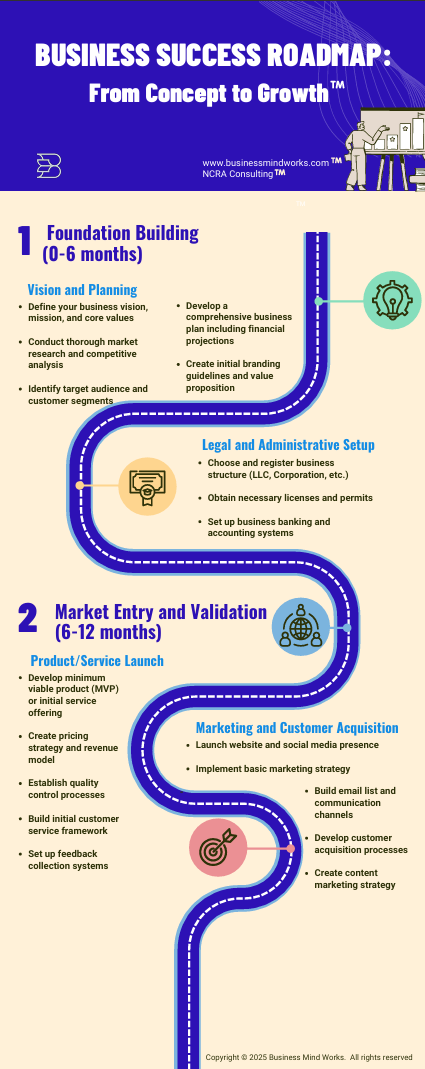
Join the Business Mind Works Affiliate Program.
FAQs
What is The Street Smart Business Program?
The Street Smart Business Program is a comprehensive online business education platform designed to help entrepreneurs and business professionals develop practical skills and knowledge. Our curriculum combines real-world business strategies with academic principles to provide you with actionable insights for business success.
Who is this program for?
This program is ideal for aspiring entrepreneurs, small business owners, and professionals looking to advance their business acumen. Whether you’re starting your first venture or seeking to scale an existing business, our courses are tailored to meet your needs.
How long do I have access to the courses?
Once enrolled, you have lifetime access to all course materials, including future updates and additional resources. Learn at your own pace and revisit the content whenever you need a refresh.
How is the program structured?
The program consists of 85+ PDF e-books and 200+ video tutorials, many Real life case studies, in addition to 800+ Business Excel templates and 200+ Motivational video reels, each focusing on essential business areas: Business Strategy, Management, Marketing, Finance, Operations, Business Restructuring, Supply Chains, Leadership, Growth & Scaling, E-commerce, Social Media marketing, Soft Skills and many other areas.
The tutorials/courses are grouped in different modules that contain videos and PDF e-books lessons, as well as real-world case studies.
Are the courses purely theoretical or practical?
Our program emphasizes practical application. While we cover fundamental business theories, the focus is on implementing these concepts in real-world situations.
What payment options are available?
It is a one-time payment of USD 195. All major credit cards are accepted.
Are there any hidden fees or additional costs?
No hidden fees. Your enrollment includes access to all course materials, the community forum, live Q&A sessions, and continuous updates to the curriculum.
















